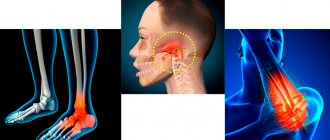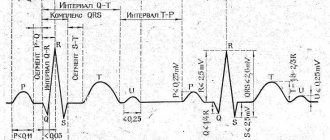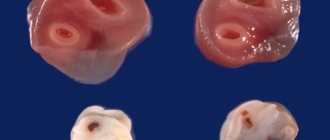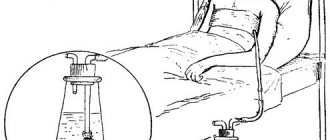Prices
| Name of service (price list incomplete) | Price |
| C-reactive protein (CRP) | 400 rub. |
In the body of every person, regardless of age, the liver produces a special compound called C-reactive protein (CRP). It helps fight infections and is involved in the healing process of injuries. When a person is healthy, the content of this protein in the blood is minimal or tends to zero. But as soon as a pathology develops in the body or an injury occurs, its concentration increases sharply after just six hours.
The C-reactive protein test is most often used to detect low-grade inflammation or infection in children that is difficult to detect by other methods. When uncontrolled, such pathologies lead to serious complications and affect the cardiovascular system. Therefore, it is so important to do timely analysis, identify the disease and carry out adequate therapy.
Standard indicators
C reactive protein, the norm of which is universal for all categories of people, makes it possible to detect inflammatory processes in the human body. But it is impossible to make a diagnosis solely on the basis of a CRP blood test.
Today it is believed that the SRP norm is up to 5 mg/l. In newborns, the level can increase to 15 mg/l. When C reactive protein is elevated, suspicions arise about the development of an inflammatory or malignant process. This means that more accurate diagnostics using other methods is required.
But since the use of high-precision equipment makes it possible to determine the minimum amount of a substance in the blood, experts have begun to apply the concept of the basic value of CRP. It was introduced to assess the risks of damage to the heart and blood vessels, in cases where the development of any inflammatory processes is excluded. The norm for the basic indicator of the substance is less than 1 mg/l.
Benefits of analysis
The CRP test is the most sensitive and fastest method for detecting inflammation or damage. Its level rises even before the child feels the first signs of illness.
The dynamics of CRP in the body corresponds to the stage of development of the pathological process. That is, the more active the infectious or autoimmune process in the body, the higher the protein content in the blood. Therefore, this indicator is also called acute phase protein. As inflammation decreases, so does CRP levels. This allows you to monitor the course of the disease and evaluate the effectiveness of the developed therapeutic regimen.
Another important indicator of acute inflammation in the body is the erythrocyte sedimentation rate (ESR). These indicators are often compared, and the analysis of CRP is considered more effective. This is due to the fact that reactive protein in a child’s blood increases earlier than ESR, and decreases faster. This allows you to observe a more current picture of the course of the disease and take appropriate measures in a timely manner.
general information
CRP (CRP, C-reactive protein) is a specific marker indicating inflammation of tissues in the body. It is produced in liver tissue under the influence of pro-inflammatory cytokines in the initial stages of pathology. C-reactive peptide activates the immune system, binds pathogenic microorganisms and cell breakdown products and promotes their removal from the body.
It is important to know that CRP also shows not only the presence of an infectious process caused by bacteria, fungi and viruses, but also indicates a high probability of atherosclerosis, reflects damage to the internal lining of blood vessels, and also helps to identify tissue necrosis.
In this regard, this indicator, in combination with other tests, is used to diagnose myocardial infarction, cerebrovascular accidents, and determine the risk of complications in heart failure and diabetes mellitus.
In surgery, C-reactive protein is determined to assess tissue healing processes.
Indications
A blood test for CRP is prescribed for children when:
- suspected infectious or inflammatory disease;
- carrying out antibacterial therapy and monitoring its effectiveness;
- there is a risk of developing cardiovascular pathologies;
- recovery and complications in the postoperative period;
- transplant operations and complications such as rejection;
- autoimmune pathologies;
- control and treatment of chronic inflammatory conditions.
The role of CRP in the diagnosis of respiratory diseases
Russian professional communities developing clinical guidelines (which were mainly approved before 2020) include the determination of CRP level in the diagnostic standard and criteria for assessing the quality of medical care for a number of nosologies:
community-acquired pneumonia
(Russian Respiratory Society, 2021, project) [5]: it is recommended to study the level of CRP in the blood serum in all hospitalized patients, especially with an uncertain diagnosis of pneumonia (absence of inflammatory infiltration in patients with a characteristic history, complaints and local symptoms). At a concentration of more than 100 mg/l, the specificity of the test in confirming the diagnosis exceeds 90%, while at a concentration of less than 20 mg/l, pneumonia is considered unlikely. The level of CRP correlates with the severity of the disease, the prevalence of inflammatory infiltration and the prognosis of the disease. Determination of the level of CRP in the blood upon admission to the hospital, as well as a decrease in the level of CRP by more than 25% from the initial value at the time of discharge are criteria for the quality of specialized medical care for adults with pneumonia [5];
chronic obstructive pulmonary disease
(COPD) (Russian Respiratory Society, 2021) [6]: a study of CRP levels is recommended in patients with exacerbation of COPD to determine indications for antibacterial therapy (with CRP levels of 10 mg/l and above);
acute respiratory viral infection
in children (Union of Pediatricians of Russia, 2021 and 2021, project) [7, 8]: it is recommended to study the level of CRP in the blood serum to exclude severe bacterial infection in children at temperatures above 38 ° C, especially in the absence of a visible focus infections. It is emphasized that a CRP level above 30–40 mg/l is more typical for bacterial infections (diagnostic accuracy is more than 85%), however, even with an adenoviral infection, the CRP level can exceed 30 mg/l;
bronchitis
in children (Union of Pediatricians of Russia, 2021 and 2021, project) [8, 9]: indications for immediate testing of CRP levels (usually in a hospital setting) are fever over 39 °C with signs of intoxication, respiratory failure, suspicion of bacterial infection, in which an indicator of a bacterial infection is a CRP level of more than 30 mg/l;
pneumonia (community acquired)
in children (Union of Pediatricians of Russia, 2021, project) [8]: indications for studying the level of CRP are the same as for bronchitis. It is emphasized that with typical community-acquired pneumonia, the level of CRP reaches more than 30–59 mg/l; with atypical (mycoplasma, chlamydial) pneumonia, the increase in CRP is less pronounced. Studying the level of CRP when there is doubt about the diagnosis of pneumonia and determining its type in hospitalized children is included in the quality criteria for specialized medical care;
acute otitis media
(National Association of Otolaryngologists, 2021) [10]: CRP level determination in severe cases is indicated.
CRP as an indicator of bacterial infection
The critical levels and dynamics of changes in the concentration of CRP in community-acquired pneumonia were determined [11]. For example, with mild pneumonia, the level of CRP is 50–60 mg/l, moderate – 90–110 mg/l, severe – 130–150 mg/l. An unfavorable sign of a severe course and an indication for intensification of antibacterial and detoxification therapy is a CRP level above 150 mg/l. In pneumococcal and legionella pneumonia, in the first 32 hours of illness, the level of CRP can be 160–170 mg/l and 178–200 mg/l, respectively [11]. The ineffectiveness of treatment is indicated by a CRP concentration of more than 100 mg/l on the 4th day of antibiotic therapy, as well as a decrease in the CRP level by less than 60% of the initial level on the 3rd day and by less than 90% of the initial level on the 7th day of antibacterial therapy. therapy [11].
The accuracy of a diagnostic test as an indicator of bacterial infection increases when it is part of the clinical evaluation algorithm for a patient with a respiratory infection [1, 2, 12]. In the recommendations of the European Respiratory Society, published in 2011, the likelihood of a diagnosis of community-acquired pneumonia was proposed to be assessed by the level of CRP: below 20 mg/l with symptoms present for more than 24 hours - the diagnosis of pneumonia is extremely unlikely; more than 100 mg/l - the diagnosis of pneumonia is assessed as probable [13].
The ability to perform rapid testing of CRP levels directly during an appointment minimizes unnecessary antibiotic therapy and does not expose patients to the risk of potential side effects. This is especially true in conditions of limited time, as well as diagnostic uncertainty, when the symptoms of viral and bacterial infections are nonspecific. Thus, a Russian randomized trial of the use of a rapid test to determine CRP levels showed that general practitioners who used the test for acute cough and/or respiratory tract infections were 21.3% less likely to prescribe antibiotics compared to the control group (where the solution was the question of prescribing an antibiotic was made only on the basis of the clinical picture) [14].
CRP as a marker of inflammation in COVID-19
The study of CRP levels during the COVID-19 pandemic not only has not lost its relevance, but has also acquired additional significance. Monitoring of inflammatory markers, including CRP, as part of a biochemical blood test for confirmed COVID-19 is included in the national recommendations of many countries, including Russia [15–18]. Moreover, according to the UpToDate resource, the concentration of CRP associated with severe COVID-19 exceeds 100 mg/l (the normal value is less than 8 mg/l) [19].
Temporary guidelines “Prevention, diagnosis and treatment of the new coronavirus infection COVID-19” (version 11 dated 05/07/2021) characterize CRP as the main laboratory marker of process activity in the lungs [18]. An increase in CRP levels correlates with the extent of lung tissue damage and is the basis for initiating anti-inflammatory therapy. Determination of CRP concentration plays a role in the diagnosis and management of patients with COVID-19 and allows us to assess:
severity, prevalence of inflammatory infiltration and prognosis of outcome of pneumonia in COVID-19. The characteristics of the moderate course of COVID-19, along with clinical indicators, also include a CRP level of more than 10 mg/l; in addition, the concentration of CRP increases in most patients simultaneously with an increase in the content of interleukin (IL) 6 and ESR;
development of acute respiratory distress syndrome (ARDS). When it develops, along with other markers (IL-6, D-dimer, ferritin, fibrinogen, triglycerides, lactate dehydrogenase), it is recommended to determine the level of CRP every 48–72 hours until a stable negative value is obtained;
development of macrophage activation syndrome. An increasing level of CRP is a laboratory indicator of progressive macrophage activation syndrome (along with an increase in ferritin levels and the development of two-three-line cytopenia);
the development of cardiovascular complications in COVID-19 is accompanied, among other things, by an increase in the level of CRP;
laboratory monitoring of patients with COVID-19 includes determining the level of CRP for moderate cases no later than 24 hours after admission, then at least 2 times a week, for severe cases at least 1 time in 2 days;
indications for pathogenetic therapy. The level of CRP is included in the list of criteria that determine the indications for prescribing pathogenetic therapy for COVID-19. Other laboratory parameters include the number of leukocytes and lymphocytes, ferritin and IL-6 levels (not always available for routine diagnosis). The indication for prescribing Janus kinase inhibitors or an IL-17 inhibitor is an increase in the level of CRP within 3-6 norms, inhibitors or blockers of IL-6 - within 6-9 norms, for prescribing IL-6 receptor inhibitors or an IL-1β inhibitor level CRP should exceed 9 norms or increase 3 times on the 8th–14th day of the disease;
indications for discharge from hospital. One of the criteria for discharge from hospital to continue treatment on an outpatient basis (until the results of laboratory testing of biological material for the presence of SARS-CoV-2 RNA) is a CRP concentration of less than 10 mg/l [18].
Preparing for the examination
In order for an analysis to detect the level of CRP in the blood to show a reliable result, it is necessary to properly prepare the child for the test:
- stop taking painkillers and antipyretic non-steroidal anti-inflammatory drugs 1-2 weeks beforehand, after consulting with your doctor;
- 2-3 days before the analysis, remove heavy physical activity;
- the day before the test, remove fatty and fried foods from your diet;
- For 8-12 hours then study, do not eat or drink anything other than water.
The analysis cannot be taken after physiotherapeutic procedures, as well as ultrasound, rectal, x-ray examination, and fluorography.
SRP and antibacterial therapy: a paradigm shift?
The COVID-19 pandemic has forced the international community to reconsider recommendations for the diagnosis and management of respiratory infections. For example, the recommendations of the UK National Institute of Health [20] for primary care physicians on the management of patients with community-acquired pneumonia previously suggested determining the level of CRP for symptoms of lower respiratory tract infection, if after a clinical study the diagnosis of pneumonia was not established and it was unclear whether to prescribe an antibiotic to the patient or not. An antibiotic should not be prescribed if the CRP level was less than 20 mg/L, if the CRP level was 20–100 mg/L, a delayed antibiotic was recommended (a prescription was given for a subsequent antibiotic if symptoms worsened), and if the CRP level was above 100 mg/L, a antibiotic. During the COVID-19 pandemic, this guidance was withdrawn and is currently being revised [20]. The Russian medical community is also expecting updated recommendations, some of them have already been published in the form of drafts [8], others are under revision. Further studies will show whether, in the long term, the doctor's decision to prescribe antibiotic therapy for respiratory infection will depend on the results of the rapid test for CRP [2, 4, 21]. The introduction of such tests into the routine practice of primary care physicians should be considered in the context of initiatives for the rational use of antibiotic therapy.
The primary care physician also faces the question of which inflammatory biomarker is best to use and whether it is advisable to prescribe several tests simultaneously. In 2021, the results of a prospective cohort study of nearly 137,000 outpatients [22] who underwent biomarker testing (including CRP or ESR, or both) for various conditions (including infections) were published. CRP testing has been shown to have greater diagnostic accuracy for infections than ESR testing, and using both tests simultaneously only marginally increases diagnostic accuracy (which is clinically controversial and economically irrational). The authors suggested that CRP levels should be used as a first-line test in most cases (infections, autoimmune conditions, cancer).
What do deviations from the norm mean?
A doctor should interpret the results. Since there is no protein in the blood of a healthy child or its concentration is minimal, there is no need to talk about a reduced level. Exceeding the normal level of CRP in the blood of children as a result of the analysis may indicate:
- up to 30 mg/l – viral diseases, systemic rheumatic pathologies, malignant diseases;
- up to 100 mg/l – acute bacterial infections, exacerbation of chronic and rheumatic pathologies, tissue damage, including after operations;
- up to 300 mg/l – extensive burns, sepsis.
Deviations from the norm are not a diagnosis and require additional examination. Depending on the clinical picture and complaints of the child, treatment can be carried out by otolaryngologists, urologists, dentists, surgeons and other specialized doctors. To establish a diagnosis and develop a treatment plan, doctors prescribe additional instrumental and laboratory tests.
Reasons for the increase
When C reactive protein is elevated, there may be different reasons. Today they are divided into three main groups:
- Oncology.
- Inflammatory processes.
- Vascular pathologies.
The risks of developing certain diseases are assessed by the concentration of the substance in the blood:
- Less than 19 mg/l. This deviation is considered insignificant. Exceeding the norm can be triggered by any negative factor affecting the body. As a rule, in this case, analysis is required at a certain frequency. If constantly elevated CRP is detected, diagnostics are required to exclude autoimmune and oncological pathologies.
- 20-50 mg/l. Indicators always rise to this level with various viral infections.
- More than 100 mg/l. A bacterial infection can provoke a strong immune reaction in the body, against which serious diseases develop: pneumonia, salmonellosis, pyelonephritis, etc.









